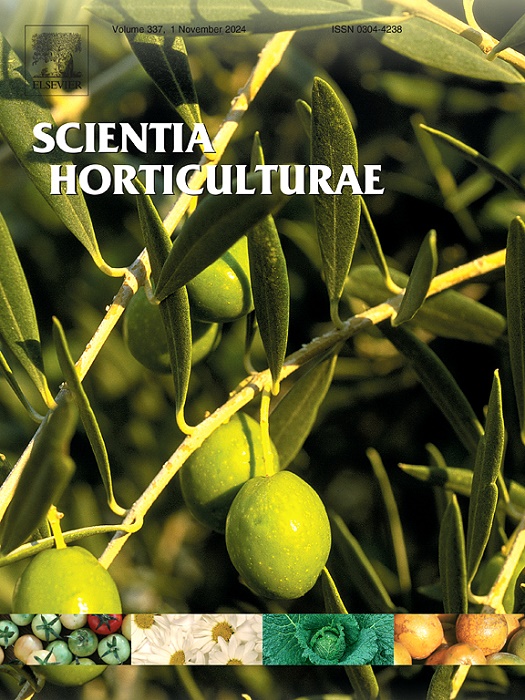IF 3.9
2区 农林科学
Q1 HORTICULTURE
引用次数: 0
摘要
目标园艺废弃物处理不当会造成资源浪费和环境负担,是园艺业的一个重要问题。温室番茄生产过程中积累的番茄植株残留物含有大量养分和有机物。在堆肥过程中,微生物会将残留物分解成营养丰富的基质。本研究在盆栽实验中调查了番茄残渣堆肥是否适合用作生产莴苣(Lactuca sativa 'Speedway')的肥料和土壤改良剂。因此,传统有机肥被100%或50%地替代。结果表明,与施肥对照组相比,添加番茄植物堆肥提高了持水量、碳含量、pH 值、宏观养分总量以及可利用的磷、钾和镁,但降低了铵和硝酸盐含量。100 % 的替代会导致产量和水利用效率降低。因此,由于植物可利用的氮释放量有限,使用堆肥番茄植株残体作为唯一的氮肥并不高效。然而,用番茄植株残体堆肥替代 50% 的常规有机肥,既能保持产量,又能保留上述积极效果。一公顷番茄生产产生的残渣有可能替代 50% 的常规肥料,用于同一公顷的生菜生产。这可以有效减少浪费,封闭营养循环,促进环境友好型园艺的发展。本文章由计算机程序翻译,如有差异,请以英文原文为准。

Closing the loop: Utilization of composted tomato plant residues as fertilizer and soil amendment
Objective
Resource waste and an environmental burden are consequences of improper disposal of horticultural waste, making it a significant concern in horticulture. Tomato plant residues that accumulate from tomato production in greenhouses, contain a lot of nutrients and organic matter. In the composting process, microorganisms decompose residues into nutrient rich substrates. If these were amended to arable land, this could save fertilizer and help to close nutrient cycles.
Methods
In the present study, it was investigated in a pot experiment whether compost from tomato residues is suitable as fertilizer and soil amendment to produce lettuce (Lactuca sativa 'Speedway'). Therefore, conventional organic fertilizer was substituted either by 100 % or 50 %. In addition, control treatments, with or without conventional organic fertilizer were cultivated.
Results
The results show that the addition of tomato plant compost increases water holding capacity, carbon content, pH, total amount of macro nutrients as well as available P, K and Mg, but reduces ammonium and nitrate content compared to the fertilized control. The 100 % substitute leads to reduced yield and water use efficiency. Therefore, using composted tomato plant residues as a sole N fertilizer is not efficient due to limited plant available N release. Yet, substituting 50 % of conventional organic fertilizer with composted tomato plant residues maintains yields while preserving the aforementioned positive effects.
Conclusion
We demonstrated that composted tomato plant residues are suitable as fertilizer and soil amendment. The residues from one hectare of tomato production have the potential to substitute 50 % of conventional fertilizer for lettuce production on one and the same hectare. This could effectively reduce waste, close nutrition cycles, and promote environmentally friendly horticulture.
求助全文
通过发布文献求助,成功后即可免费获取论文全文。
去求助
来源期刊

Scientia Horticulturae
农林科学-园艺
CiteScore
8.60
自引率
4.70%
发文量
796
审稿时长
47 days
期刊介绍:
Scientia Horticulturae is an international journal publishing research related to horticultural crops. Articles in the journal deal with open or protected production of vegetables, fruits, edible fungi and ornamentals under temperate, subtropical and tropical conditions. Papers in related areas (biochemistry, micropropagation, soil science, plant breeding, plant physiology, phytopathology, etc.) are considered, if they contain information of direct significance to horticulture. Papers on the technical aspects of horticulture (engineering, crop processing, storage, transport etc.) are accepted for publication only if they relate directly to the living product. In the case of plantation crops, those yielding a product that may be used fresh (e.g. tropical vegetables, citrus, bananas, and other fruits) will be considered, while those papers describing the processing of the product (e.g. rubber, tobacco, and quinine) will not. The scope of the journal includes all horticultural crops but does not include speciality crops such as, medicinal crops or forestry crops, such as bamboo. Basic molecular studies without any direct application in horticulture will not be considered for this journal.
 求助内容:
求助内容: 应助结果提醒方式:
应助结果提醒方式:


